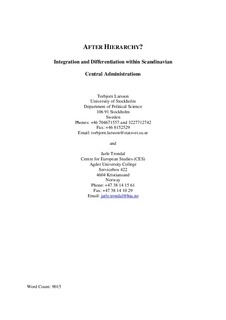After hierarchy? : integration and differentiation within Scandinavian Central Administrations
Abstract
This study demonstrates that the differentiated organisatational constellation of the European Union (EU) contribute to a differentiated penetration of domestic government decision-making processes. The question posed is how different EU institutions, notably the European Commission and the Council of Ministers, accompany a differentiated level of hierarchical decision-making processes within domestic central administrations. To account for this differentiated impact, this study outlines two theoretical approaches: one ‘administrative integration approach’ claiming that different EU institutions have a differentiated impact on domestic hierarchical governance, and one ‘administrative robustness approach’ advocating the differentiated “EU effect” is filtered, mediated and modified through existing domestic decision-making routines and practices. This article compares the actual decision-making processes within the central administrative apparatus of two countries which are differentially integrated in the EU, Norway and Sweden. The empirical analysis, based on a rich body of existing survey and interview data, indicates that the European Commission informally activates the lower echelons of the domestic government hierarchies, notably sector experts within sector agencies and sector ministries. Furthermore, the European Commission tend to de-activate the domestic politico-administrative leadership, the Foreign Office and the Prime Ministers Office. By contrast, the Council of Ministers seems to strengthen the formal domestic pyramidal hierarchy of governance. Consequently, in the case of Norway a strong informal penetration happens between the European Commission and domestic government institutions largely outside the control of the domestic politicoadministrative leadership. In Sweden this tendency is somewhat counterbalanced due to the inter-sectorally interlocking effect of the Council of Ministers. Finally, this study highlights that domestic government institutions, to some extent, bias and filters the differentiated effect of the European Commission and the Council of Ministers.
